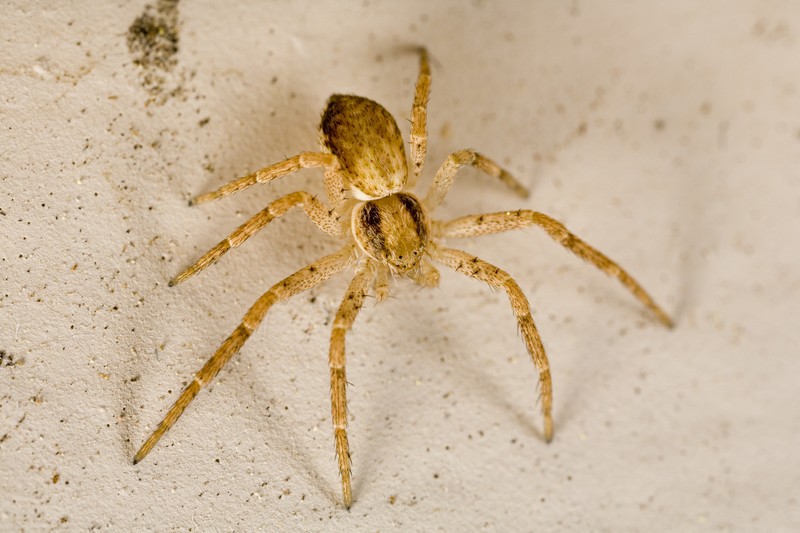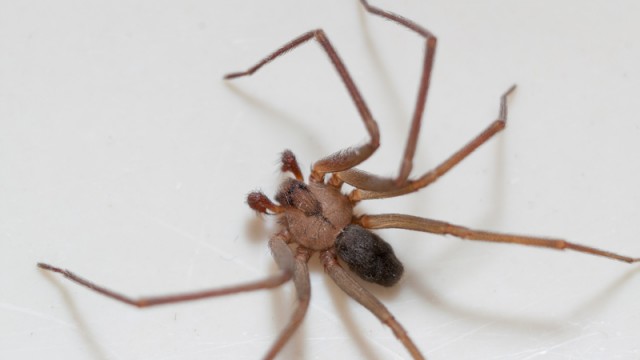There aren’t that many extremely dangerous spiders in North America, but the ones who are have gone on to fuel our fear and loathing of these largely benign creepy-crawlies. Take a look at a few of the most frightening ones below.
1. Recluse Spiders (Loxosceles)
This species measures 6 to 18 mm (1/4 to 3/4 inch) in body length. A dark violin shape is located on the top of the leg attachment region with the neck of the violin pointing backward toward the abdomen. When most spiders have 8 eyes, Recluse Spiders has only 6 arranged in pairs – one pair in front and a pair on either side.The Brown Recluse Spider's venom can cause significant cutaneous injury with tissue loss and necrosis, and can be deadly to humans. However, though it is very dangerous to people, it is not an aggressive species and it only bites when threatened.
2. Widows (Latrodectus)
The Black Widow Spider is notorious at being one of the most venomous spiders in the world. It inflicts a painful bite which can be fatal, especially to the young and elderly. Only a small amount of venom can cause serious illness, as the neurotoxic poison (which is 15 times as toxic as the venom of a prairie rattlesnake) attacks the nervous system. Systemic envenomisation usually results in headache, nausea, vomiting, abdominal pain, pyrexia and hypertension. Though the pain around the bite area can be extremely painful, it sometimes goes unnoticed. First aid and medical attention should be sought as soon as possible. People with heart condition or other heart problem, may require hospitalization.3. Hobo Spider (Tegenaria agrestis)
Though the bite of a Hobo Spider is initially painless, it can, nevertheless, be serious. A redness will first appear around the bite site, which will develop into a blister after 24 hours, before breaking open, leaving an open, oozing ulceration.The bite might also cause severe headaches lasting 2 to 7 days and even nausea, weakness, fatigue, malaise, temporary memory loss and vision impairment.
Severe lesions may take several months to heal and the Hobo Spider has been identified as a contributory factor to at least one death. Medical attention should be sought, when bitten, and when any adverse health effects are observed.
4. Yellow Sac Spiders, Black-footed Spider (Cheiracanthium inclusum or mildei)
Yellow Sac Spiders are often found in homes throughout the American continent. They build silk retreats in curled leaves or in crevices. Bites usually occur at night when these nocturnal hunters encounter a sleeping human. In fact, Yellow Sac Spiders are believed to be responsible for the majority of nuisance bites to humans in North America. This species has a mildly toxic venom. Bites can be painful and cause skin irritations: erythema, edema and pruritis. Yet, though wounds may become slightly necrotic, they usually heal in rather rapidly without severe scarring.
Usually, it’s not recommended that you go sticking your fingers in deep dark crevices with an unprotected hand, and not only for the fear of spiders. You should also follow a general rule of watching out for telltale spider signs, such as a web or anyplace where a spider could make a cozy home without fear of being discovered.
Spiders generally prefer to be left alone, so there is typically very little chance of running into one of these deadly biters. Still, learn to recognize the dangerous ones and get medical attention the second you get bitten in order to lessen the effects.
If you'd like to learn more about these potentially dangerous spiders and how you can recognize and avoid them, read more at Venomous, Poisonous, Dangerous, and Other Wonders.





Nate Gentz
They are not even spiders/arachnids….thought everyone knew this.
I say KILL ALL SPIDERS!
The most highly toxic spider is a daddy long legs… their fangs are too small to puncture our skin
Trump for president 2016
Spiders scare me worse than anything else.
Not the “daddy long legs” they’re talking about being venomous
Kill’em ALL
Josey Fields you might find this good reading material. 😉
Gaaaaaaaaaaaaaaaawd
Tommy Judge Absolutely false. There are 2 creatures often called daddy long legs. First one, the opilione, does not have venom glands or fangs, or any other adaptation for killing its food with injected chemicals of any sort.
Second is the pholcidae, this spider has never bitten a human and caused a bad reaction and it is not due to its fangs being too weak. Brown recluse have the same kind of fang structure as the pholcidae and their bites on humans are well documented and feared accordingly.
Myth busters did a test to try and get bit by a pholcidae and they were successful. The “victim” hardly showed signs of even minor irritation.
Debbie Sue Hansen
Spent the other night trying to chase the AZ version of the brown recluse around my shop. Finally got the raid out. Got bit by one a few years ago and really got a bad reaction to it.
I know this isn’t a political page but at least it’s a “thinker page”……use your mind and set your butt free!
Here is a poll I created. THESE numbers seem more legit to me. But there are only like 130 votes but Clinton is in 3rd place behind Johnson! That seems legit.
I would like this to go viral so we could get an unbiased poll. Share it with liberals and conservatives alike so we get accurate numbers.
It’s a single click. No gimmicks or click bait. Vote and share the poll link please.
https://www.facebook.com/thetruththewholeuglytruth/posts/1185896204799917
Nate Gentz if you eat one. They can’t bite.
Creepy .. I keep lots of raid around
Josh Simmons
Jayme Oliver-Richison
There is a difference between venom and poison.
Most spiders are venomous, many will hurt you, even if they aren’t extremely harmful in the long term.
Daddy long legs are not the most venomous. I did another response on this, to another person’s comments.
There are 2 kinds of arachnids called daddy long legs, one has no venom gland and the other has never produced a fatal or dangerous bite ever, despite having bitten humans.
And as noted above, the ones that can bite, have the exact same fangs as a brown recluse, whose bite can obviously penetrate skin.
There are hordes of knowledge for you to access, yet you try to insult someone who actually has knowledge about it as a redneck.
lol Daddy long leg is not the most venomous spider in the U.S., let alone the world.
Brazillian wandering spider will mess your day up a thousand times over, if it bites you.
They actually have fangs which to deliver their venom. A venom so potent, it makes a black widow’s bite look mild in comparison. In comparison, it rates up there with venomous snakes.
Wolf spider.